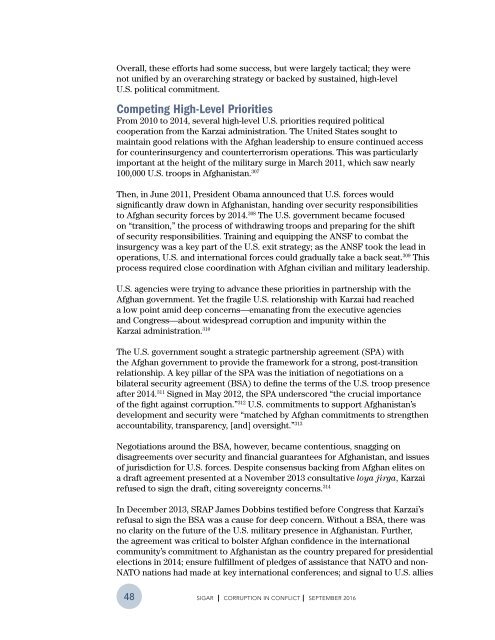CORRUPTION IN CONFLICT
5IlaWjQej
5IlaWjQej
Create successful ePaper yourself
Turn your PDF publications into a flip-book with our unique Google optimized e-Paper software.
Overall, these efforts had some success, but were largely tactical; they were<br />
not unified by an overarching strategy or backed by sustained, high-level<br />
U.S. political commitment.<br />
Competing High-Level Priorities<br />
From 2010 to 2014, several high-level U.S. priorities required political<br />
cooperation from the Karzai administration. The United States sought to<br />
maintain good relations with the Afghan leadership to ensure continued access<br />
for counterinsurgency and counterterrorism operations. This was particularly<br />
important at the height of the military surge in March 2011, which saw nearly<br />
100,000 U.S. troops in Afghanistan. 307<br />
Then, in June 2011, President Obama announced that U.S. forces would<br />
significantly draw down in Afghanistan, handing over security responsibilities<br />
to Afghan security forces by 2014. 308 The U.S. government became focused<br />
on “transition,” the process of withdrawing troops and preparing for the shift<br />
of security responsibilities. Training and equipping the ANSF to combat the<br />
insurgency was a key part of the U.S. exit strategy; as the ANSF took the lead in<br />
operations, U.S. and international forces could gradually take a back seat. 309 This<br />
process required close coordination with Afghan civilian and military leadership.<br />
U.S. agencies were trying to advance these priorities in partnership with the<br />
Afghan government. Yet the fragile U.S. relationship with Karzai had reached<br />
a low point amid deep concerns—emanating from the executive agencies<br />
and Congress—about widespread corruption and impunity within the<br />
Karzai administration. 310<br />
The U.S. government sought a strategic partnership agreement (SPA) with<br />
the Afghan government to provide the framework for a strong, post-transition<br />
relationship. A key pillar of the SPA was the initiation of negotiations on a<br />
bilateral security agreement (BSA) to define the terms of the U.S. troop presence<br />
after 2014. 311 Signed in May 2012, the SPA underscored “the crucial importance<br />
of the fight against corruption.” 312 U.S. commitments to support Afghanistan’s<br />
development and security were “matched by Afghan commitments to strengthen<br />
accountability, transparency, [and] oversight.” 313<br />
Negotiations around the BSA, however, became contentious, snagging on<br />
disagreements over security and financial guarantees for Afghanistan, and issues<br />
of jurisdiction for U.S. forces. Despite consensus backing from Afghan elites on<br />
a draft agreement presented at a November 2013 consultative loya jirga, Karzai<br />
refused to sign the draft, citing sovereignty concerns. 314<br />
In December 2013, SRAP James Dobbins testified before Congress that Karzai’s<br />
refusal to sign the BSA was a cause for deep concern. Without a BSA, there was<br />
no clarity on the future of the U.S. military presence in Afghanistan. Further,<br />
the agreement was critical to bolster Afghan confidence in the international<br />
community’s commitment to Afghanistan as the country prepared for presidential<br />
elections in 2014; ensure fulfillment of pledges of assistance that NATO and non-<br />
NATO nations had made at key international conferences; and signal to U.S. allies<br />
48<br />
SIGAR I <strong>CORRUPTION</strong> <strong>IN</strong> <strong>CONFLICT</strong> I SEPTEMBER 2016


